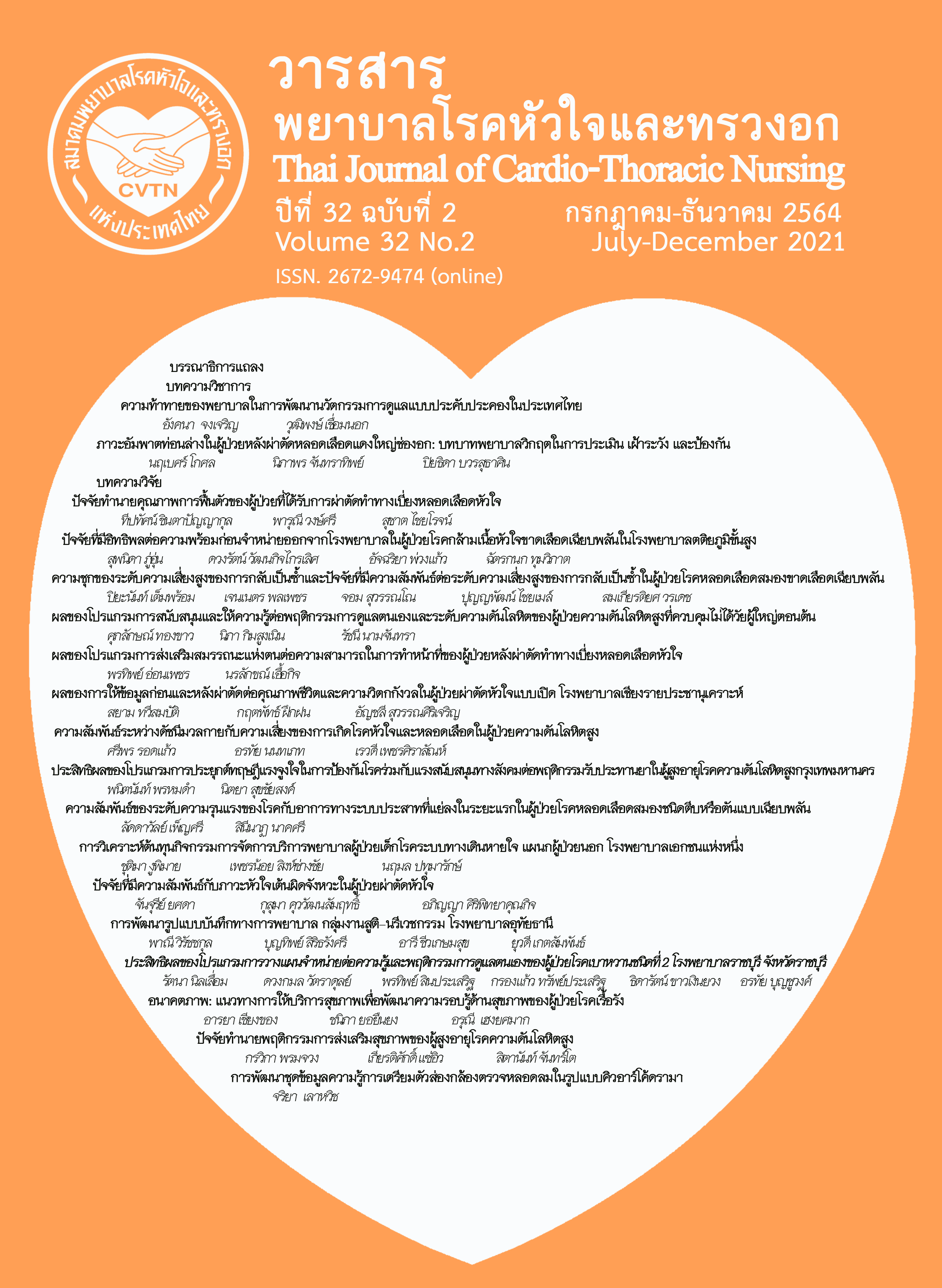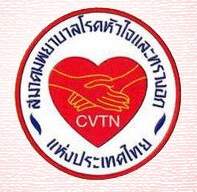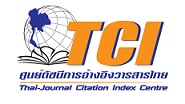Development of educational information with Rama bronchoscopy QR code
Keywords:
bronchoscopy, educational information of bronchoscopy, QR code, Life satisfactionAbstract
This study aimed to develop and evaluate educational Information for patients undergoing bronchoscopy and satisfaction with educational Information with Rama Bronchoscopy QR Code. The samples consisted of 157 who were undergoing bronchoscopy. Data were collected by encourage patients to use educational Information with Rama Bronchoscopy QR Code between January to June, 2018 and evaluate by using satisfaction questionnaire of educational Information with Rama Bronchoscopy QR Code. Data were analyzed using descriptive statistic.
The results showed that the mean score of total four aspects of the satisfaction on the “Educational Information with Rama Bronchoscopy QR Code” were at a high level. For instance, the value of the “Educational Information with Rama Bronchoscopy QR Code” were updated, comfortable and timely used and patients rated as a high level. In addition, the purpose of self- preparation of Bronchoscopy was relevancy, safety with clearly graphic and friendly used.
The study suggests that healthcare providers should consider to implement this educational Information with Rama Bronchoscopy QR Code to promote patients access to convenience and friendly used information for preparation of bronchoscopy.
References
Vaidya P, Leuppi J, Chhajed PN. The evolution of flexible bronchoscopy: From historical luxury to utter necessity. Lung India. 2015; 32: 208-10.
Vander EH, Casal RF, Trisolini R, Steinfort DP, Hwangbo B, Nakajima T, et al. Guideline for the acquisition and preparation of conventional and endobronchial ultrasound-guided transbronchial needle aspiration specimens for the diagnosis and molecular testing of patients with known or suspected lung cancer. Respiration. 2014; 88: 500-17.
Bellinger CR, Chatterjee AB, Adair N, Houle T, Khan I, Haponik E. Training in and experience with endobronchial ultrasound. Respiration. 2014; 88: 478-82.
Statistics of bronchoscope records. Division of pulmonary and critical care, Department of medicine, Faculty of Medicine Ramathibodi Hospital; 2008-2014. (in Thai).
Kuankhajorn W, Tabtimsuwan S, Kasetsermviriya S, Danwiriyakul W, Ampawat W, Chaiyawat R.The effect of video compact disc on gastroscopy patients’ anxiety. Siriraj Nursing Journal. 2009; 3(1): 25-31. (in Thai).
Chinwattana K, Senngam K, RatasampunS. The effect of preparatory information on level of anxiety in heart disease patient undergoing tranesophageal echocardiography. Chest Disease Institute Journal. 2012; 10(2): 8-17. (in Thai).
Laohavich C, Choothakan S, Laungdamrongchai S, Vinithanont A. Effect of Using the Guideline in Preparing Patients for Bronchoscopy Appointment on the Rate of Appointment Postponement and Cancellation in Patients undergoing Bronchoscopy. Rama Nursing Journal. 2014; 21(1): 1-11. (in Thai).
Laohavich C, Choothakan S, Tipparaj B. Effect of Educational Information with Video Compact Disc on Anxiety Level of Patients Undergoing Bronchoscopy. Rama Nursing Journal. 2017; 23(2): 195-207. (in Thai).
Gunay E, Baki E, Kokulu S, Ulasi S, Gurhan O, Olcay A, et al. Impact of multimedia information on bronchoscopy procedure: is it really helpful? Ann Thoracic Med. 2015; 10: 34–37.
Thomas S, Sugirtha V. Effectiveness of structured teaching programme on knowledge and anxiety of patients undergoing endoscopy at a gastroenterology centre of a tertiary care hospital. Int J Sci Res. 2015; 6: 1017–1120.
Deming, W E. Out of the crisis. Cambridge, MA: Massachusetts Institute of Technology Press; 1986.
Benore E, Enlow T. Compliance with EEG; decreasing procedure anxiety and behavior distress. Eplipsy Behavior. 2013; 27: 169–73.
Boromtanarat P. Effectiveness of information provision using video media on anxiety reduction and complication reduction on phacoemulsifi cation with intraocular lens implantation, Suratthani Hospital. Med J. 2016; 30(3): 129-37.
Association of Peri Operative Registered Nurses (AORN). Perioperative standards and recommended practices for inpatient and ambulatory settings. Denver (CO): AORN. 2013: 302-22.
Kent EP, Mary H, MeiLan KH, Claude JL, Laura SV, William JM, et al. Women and Lung Disease. Sex Differences and Global Health Disparities. Am J Respir Crit Care Med. 2015; 192(1): 11–16.
Soo JC, Heather WS. Aging and Lung Disease. Annu Rev Physiol. 2020; 82(10): 433-459.
David EO, Armin E, Xiudong L, Kevin LK, Sadia B, Javier DM, et al. Diagnostic Yield and Complications of Bronchoscopy for Peripheral Lung Lesions: Results of the AQuIRE Registry. Am J Respir Crit Care Med. 2016; 193(1): 68-77.
Molen B. Relating information needs to bronchoscope experience: Information as a key coping strategy. Eur J Bronchoscope Care. 2011; 8: 238–244.
Catherine S, Paul F, Kwun M, Chantal FS. High-risk respiratory patients' experiences of bronchoscopy with conscious sedation and analgesia: a qualitative study. J. Clin. Nurs. 2018; 27(13-14): 2740-51.
Jaeho C, Gi WS, Jeong S, Hyung K, Eun M, Jahyung K, et al. The usefulness of the QR Code in Orthotic Applications after Orthopedic Surgery. Healthcare (Basel). 2021; 9(3): 298.
Jingwen H, Jie R, Jie Z, Zhijian L , Xianghua X .A quasi-experimental study examining QR code-based video education program on anxiety, adherence, and satisfaction in coronary angiography patients. Contemp Nurse. 2020; 56(5-6): 428-40.
Downloads
Published
How to Cite
Issue
Section
License
Copyright (c) 2022 Thai Journal of Cardio-Thoracic Nursing

This work is licensed under a Creative Commons Attribution-NonCommercial-NoDerivatives 4.0 International License.
บทความนี้ยังไม่เคยตีพิมพ์หรืออยู่ในระหว่างส่งไปตีพิมพ์ในวารสารอื่น ๆ มาก่อน และกองบรรณาธิการขอสงวนสิทธิ์ในการตรวจทาน และแก้ไขต้นฉบับตามเกณฑ์ของวารสาร ในกรณีที่เรื่องของท่านได้ได้รับการตีพิมพ์ในวารสารฉบับนี้ถือว่าเป็น ลิขสิทธิ์ของวารสารพยาบาลโรคหัวใจและทรวงอก





